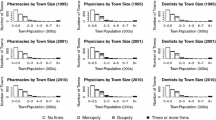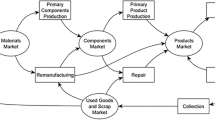Abstract
We investigate how the initial distribution of scarce human resources determines the equilibrium industry structure. Using a two-firm competition model with resource-dependent production technology, we examine the flow of these resources in gradual trading, one-off trading, and Walrasian trading. We find that the evolution of an industry’s structure depends on the total amount of resources available relative to the market size. When resources are plentiful, a symmetric duopoly emerges through the trading of the resources. In all three models, a monopoly emerges when the resources are sufficiently scarce. This is in contrast to the results obtained by many existing models of capacity found in the literature.



Similar content being viewed by others
Notes
The lifetime contract rescission clauses for the pilots market in China are deemed necessary because the training costs are very high compared to a trainee’s initial income, and there is a risk of failure in becoming a qualified pilot after a long and expensive training process.
In the above example of the airline industry, the airline becomes more flexible with the more pilots it employs, and it can more cheaply provide flight services to its customers.
If the marginal cost of production increases in the amount of resources, then the industry will evolve into a symmetric duopoly. The intuition is simple. When a firm has a large stock of resources, it is eager to sell some of them to the other firm to reduce its marginal cost. This will become clearer later in the analysis.
References
Besanko D, Doraszelski U (2004) Capacity dynamics and endogenous asymmetries in firm size. RAND J Econ 35(1):23–49
Besanko D, Doraszelski U, Kryukov Y (2014) The economics of predation: what drives pricing when there is learning-by-doing? Am Econ Rev 104(3):868–897
Borenstein S (1989) Hubs and high fares: dominance and market power in the U.S. airline industry. RAND J Econ 20(3):344–365
Borenstein S (1991) The dominant-firm advantage in multiproduct industries: evidence from the U.S. airlines. Quart J Econ 106(4):1237–1266
Borenstein S (1992) The evolution of U.S. airline competition. J Econ Perspect 6(2):45–73
D’Aspremont C, Jacquemin A (1988) Cooperative and non-cooperative R & D in duopoly with spillovers. Am Econ Rev 78(5):1133–1137
Eső P, Nocke V, White L (2010) Competition for scarce resources. RAND J Econ 41(3):524–548
Farrell J, Shapiro C (1990) Asset onership and market structure in oligopoly. RAND J Econ 21(2):275–292
Gale I (1994) Competition for scarce inputs: the case of airport takeoff and landing slots. Federal Reserve Bank Clevel Econ Rev QII:18–25
Gardner TM (2002) In the trenches at the talent wars: competitive interaction for scarce human resources. Hum Resour Manag 41(2):225–237
Gardner TM (2005) Interfirm competition for human resources: evidence from the software industry. Acad Manag J 48(2):237–256
Gilbert RJ, Newbery DMG (1982) Pre-emptive patenting and the persistence of monopoly. Am Econ Rev 72(3):514–26
Horn H, Persson L (2001) The equilibrium ownership of an international oligopoly. J Int Econ 53(2):307–333
Jehiel P, Moldovanu B (1996) Strategic non-participation. RAND J Econ 27(1):84–98
Jehiel P, Moldovanu B (2000) Auctions with downstream interaction among buyers. RAND J Econ 31(4):768–791
Jehiel P, Moldovanu B, Stacchetti E (1996) How (not) to sell nuclear weapons. Am Econ Rev 86(4):814–829
Kamien MI, Muller E, Zang I (1992) Research joint ventures and R&D cartels. Am Econ Rev 82(5):1293–1306
Kamien MI, Tauman Y (1986) Fees versus royalties and the private value of a patent. Quart J Econ 101(3):471–492
Katz ML, Shapiro C (1985a) Network externalities, competition, and compatibility. Am Econ Rev 75(3):424–440
Katz ML, Shapiro C (1985b) On the licensing of innovations. RAND J Econ 16(4):504–520
Katz ML, Shapiro C (1986) How to license intangible property. Quart J Econ 101(3):567–590
Marx LM, Shaffer G (2004) Slotting allowances and scarce shelf space. Working Paper, Fuqua School of Business, Duke University
Perry MK, Porter RH (1985) Oligopoly and the incentive for horizontal merger. Am Econ Rev 75(1):219–227
Rao H, Drazin R (2002) Overcoming resource constraints on product innovation by recruiting talent from rivals: a study of the mutual fund industry, 1986–1994. Acad Manag J 45(3):491–507
Riordan M (1998) Anti-competitive vertical integration by a dominant firm. Am Econ Rev 88(5):1232–1248
Acknowledgements
We would like to thank the editor, Giacomo Corneo, and two anonymous referees for their very constructive comments. We would also like to thank Volker Nocke, Yossi Spiegel, Paul Belleflamme and the participants at a seminar at Zhejiang University, the Industrial Economics Conference at Shandong University, the Conference in Industrial Economics at Southwest University of Finance and Economics, the World Congress of the International Economics Association, and the Asian Meetings of the Econometric Society for their helpful comments, and LetPub for their editorial assistance. Song would like to acknowledge the financial support from the National Natural Science Foundation of China Projects (71232013), Zhongying Young Scholar Program, and Fundamental Research Funds for the Central Universities of China. Wang would like to acknowledge the financial support from the SSHRC of Canada and Zhejiang University. Ye would like to acknowledge the financial support from the Chinese National Social Science Fund Project (No. 13CJY105).
Author information
Authors and Affiliations
Corresponding author
Appendix: Proof of Proposition 3
Appendix: Proof of Proposition 3
Proof
We shall prove the first half of this proposition in 2 directions.
(i) If \(w^{*}\), \(N_{i}(w^{*})\) and \(N_{j}(w^{*})\) constitute a Walrasian equilibrium, then for any \(N_{i}+N_{j}=N\), we have
Noting that \(N_{i}^{0}+N_{j}^{0}=N\) and that \(N_{i}(w^{*})+N_{j}(w^{*})=N\), the sum of the above 2 inequalities leads to
for any \(N_{i}+N_{j}=N\). In this case, \(N_{i}^{*}=N_{i}(w^{*})\) and \(N_{j}^{*}=N_{j}(w^{*})\).
(ii) For any \(N_{i}^{*}\) and \(N_{j}^{*}\) that maximize (13), we need to show that there exists a \(w^{*}\), such that \(N_{i}(w^{*})=N_{i}^{*}\) and \(N_{j}(w^{*})=N_{j}^{*}\).
We need to discuss 2 cases. In case 1, \(N_{i}^{*}\) and \(N_{j}^{*}\) form a corner solution. Without a loss of generality, let \(N_{i}^{*}=N\) and \(N_{j}^{*}=0\). Then we must have
Any \(w^{*} \in [V_j,V_i]\) would induce the corner solution \(N_{i}(w^{*})=N\) and \(N_{j}(w^{*})=0\). This configuration constitutes a Walrasian equilibrium.
In case 2, \(N_{i}^{*}\) and \(N_{j}^{*}\) form an interior solution. In this case,
Let \(w^{*} = V_i =V_j\). Then the first order condition (15) is satisfied for firm i and for firm j. From (6), we have
By subtracting the first equation from the second, we obtain [c.f. inequality (8)]
From (18), we have 2 solutions. Solution 1 gives \(c_{i}=c_{j}\). Solution 2 gives
The second order condition for maximization (13) implies that
Note that
Combining the above 2 equations, we obtain
as required by the second order condition of the joint profit maximization.
Solution 2 [Eq. (19) above] from the first order condition obviously does not satisfy this second order condition. Solution 1 (i.e., \(c_{i}=c_{j}\)) does satisfy this second order condition. This is because at \(c_{i}=c_{j}\), \({dV_{i}(N_{i}^{*},N_{j}^{*})}/{dN_{i}}= {dV_{j}(N_{i}^{*},N_{j}^{*})}/{dN_{j}}\), and therefore, (20) implies that both \({dV_{i}}/{dN_{i}}\) and \({dV_{j}}/{dN_{j}}\) are non-positive. This concludes the proof for the first half of this proposition. The second half of the proposition is immediate from the proof. \(\square \)
Rights and permissions
About this article
Cite this article
Song, H., Wang, R. & Ye, J. Scarce human resources and equilibrium industry structure. J Econ 124, 99–119 (2018). https://doi.org/10.1007/s00712-017-0566-0
Received:
Accepted:
Published:
Issue Date:
DOI: https://doi.org/10.1007/s00712-017-0566-0




